relay RENAULT TWINGO RS 2009 2.G Electrical Equipment - Petrol Injection Owner's Manual
[x] Cancel search | Manufacturer: RENAULT, Model Year: 2009, Model line: TWINGO RS, Model: RENAULT TWINGO RS 2009 2.GPages: 348
Page 69 of 348
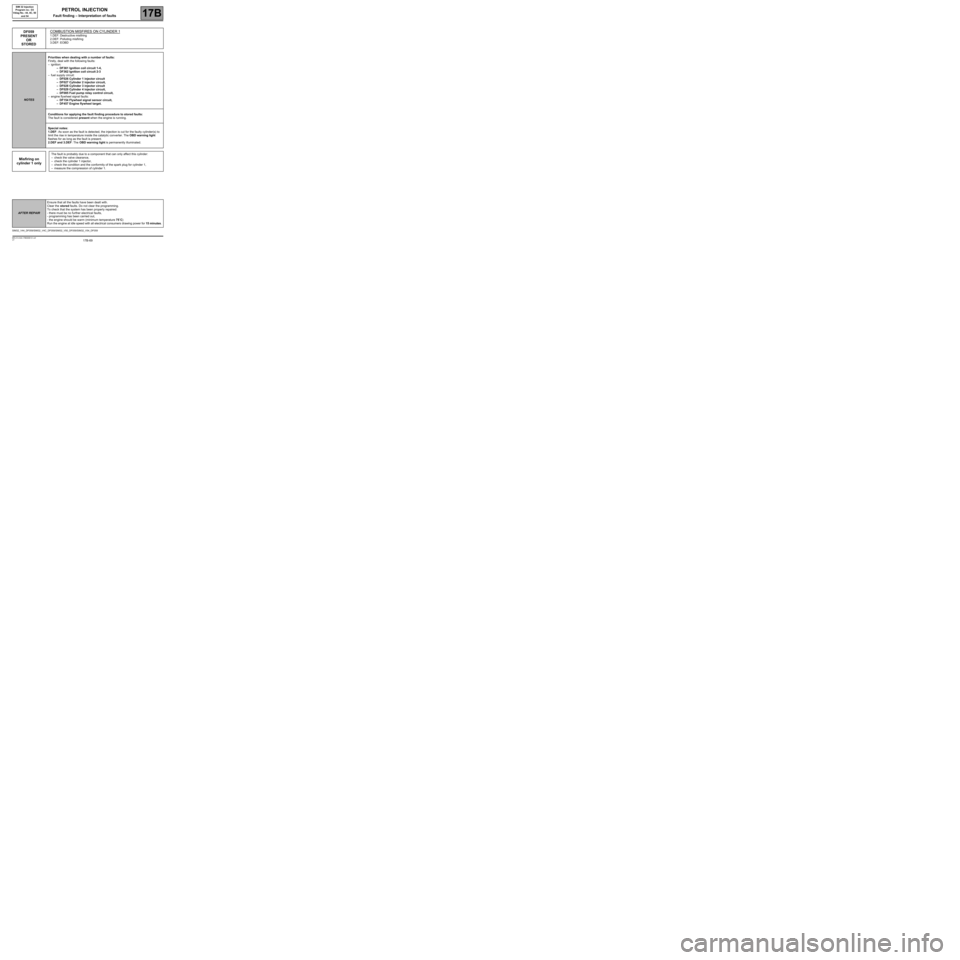
17B-69V7 MR-413-X44-17B000$131.mif
PETROL INJECTION
Fault finding – Interpretation of faults17B
SIM 32 Injection
Program no.: D3
Vdiag No.: 44, 4C, 50
and 54
DF059
PRESENT
OR
STOREDCOMBUSTION MISFIRES ON CYLINDER 1
1.DEF: Destructive misfiring
2.DEF: Polluting misfiring
3.DEF: EOBD
NOTESPriorities when dealing with a number of faults:
Firstly, deal with the following faults:
–ignition:
–DF361 Ignition coil circuit 1-4,
–DF362 Ignition coil circuit 2-3
–fuel supply circuit:
–DF026 Cylinder 1 injector circuit
–DF027 Cylinder 2 injector circuit,
–DF028 Cylinder 3 injector circuit
–DF029 Cylinder 4 injector circuit,
–DF085 Fuel pump relay control circuit,
–engine flywheel signal faults:
–DF154 Flywheel signal sensor circuit,
–DF457 Engine flywheel target.
Conditions for applying the fault finding procedure to stored faults:
The fault is considered present when the engine is running.
Special notes:
1.DEF: As soon as the fault is detected, the injection is cut for the faulty cylinder(s) to
limit the rise in temperature inside the catalytic converter. The OBD warning light
flashes for as long as the fault is present.
2.DEF and 3.DEF: The OBD warning light is permanently illuminated.
Misfiring on
cylinder 1 only
The fault is probably due to a component that can only affect this cylinder:
–check the valve clearance,
–check the cylinder 1 injector,
–check the condition and the conformity of the spark plug for cylinder 1,
–measure the compression of cylinder 1.
SIM32_V44_DF059/SIM32_V4C_DF059/SIM32_V50_DF059/SIM32_V54_DF059
AFTER REPAIREnsure that all the faults have been dealt with.
Clear the stored faults. Do not clear the programming.
To check that the system has been properly repaired:
- there must be no further electrical faults,
- programming has been carried out,
- the engine should be warm (minimum temperature 75˚C)
Run the engine at idle speed with all electrical consumers drawing power for 15 minutes.
Page 72 of 348
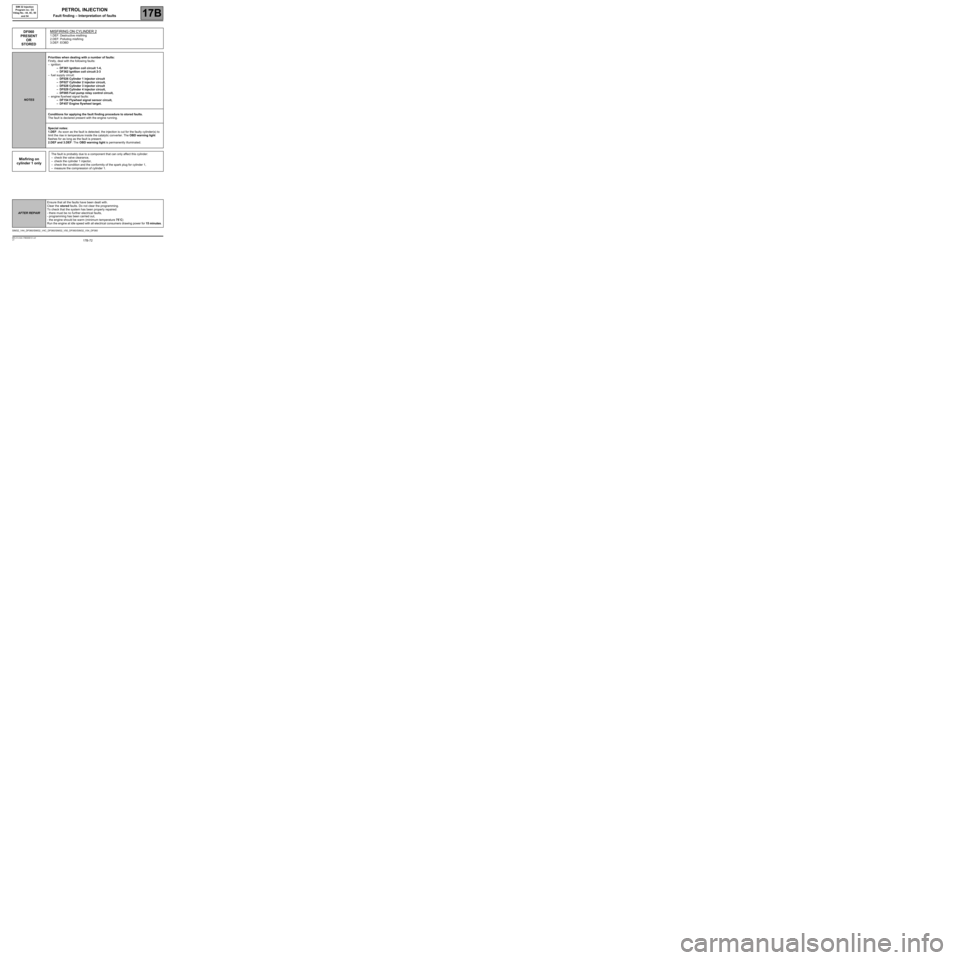
17B-72V7 MR-413-X44-17B000$131.mif
PETROL INJECTION
Fault finding – Interpretation of faults17B
SIM 32 Injection
Program no.: D3
Vdiag No.: 44, 4C, 50
and 54
DF060
PRESENT
OR
STOREDMISFIRING ON CYLINDER 2
1.DEF: Destructive misfiring
2.DEF: Polluting misfiring
3.DEF: EOBD
NOTESPriorities when dealing with a number of faults:
Firstly, deal with the following faults:
–ignition:
–DF361 Ignition coil circuit 1-4,
–DF362 Ignition coil circuit 2-3
–fuel supply circuit:
–DF026 Cylinder 1 injector circuit
–DF027 Cylinder 2 injector circuit,
–DF028 Cylinder 3 injector circuit
–DF029 Cylinder 4 injector circuit,
–DF085 Fuel pump relay control circuit,
–engine flywheel signal faults:
–DF154 Flywheel signal sensor circuit,
–DF457 Engine flywheel target.
Conditions for applying the fault finding procedure to stored faults.
The fault is declared present with the engine running.
Special notes:
1.DEF: As soon as the fault is detected, the injection is cut for the faulty cylinder(s) to
limit the rise in temperature inside the catalytic converter. The OBD warning light
flashes for as long as the fault is present.
2.DEF and 3.DEF: The OBD warning light is permanently illuminated.
Misfiring on
cylinder 1 only
The fault is probably due to a component that can only affect this cylinder:
–check the valve clearance,
–check the cylinder 1 injector,
–check the condition and the conformity of the spark plug for cylinder 1,
–measure the compression of cylinder 1.
SIM32_V44_DF060/SIM32_V4C_DF060/SIM32_V50_DF060/SIM32_V54_DF060
AFTER REPAIREnsure that all the faults have been dealt with.
Clear the stored faults. Do not clear the programming.
To check that the system has been properly repaired:
- there must be no further electrical faults,
- programming has been carried out,
- the engine should be warm (minimum temperature 75˚C)
Run the engine at idle speed with all electrical consumers drawing power for 15 minutes.
Page 75 of 348
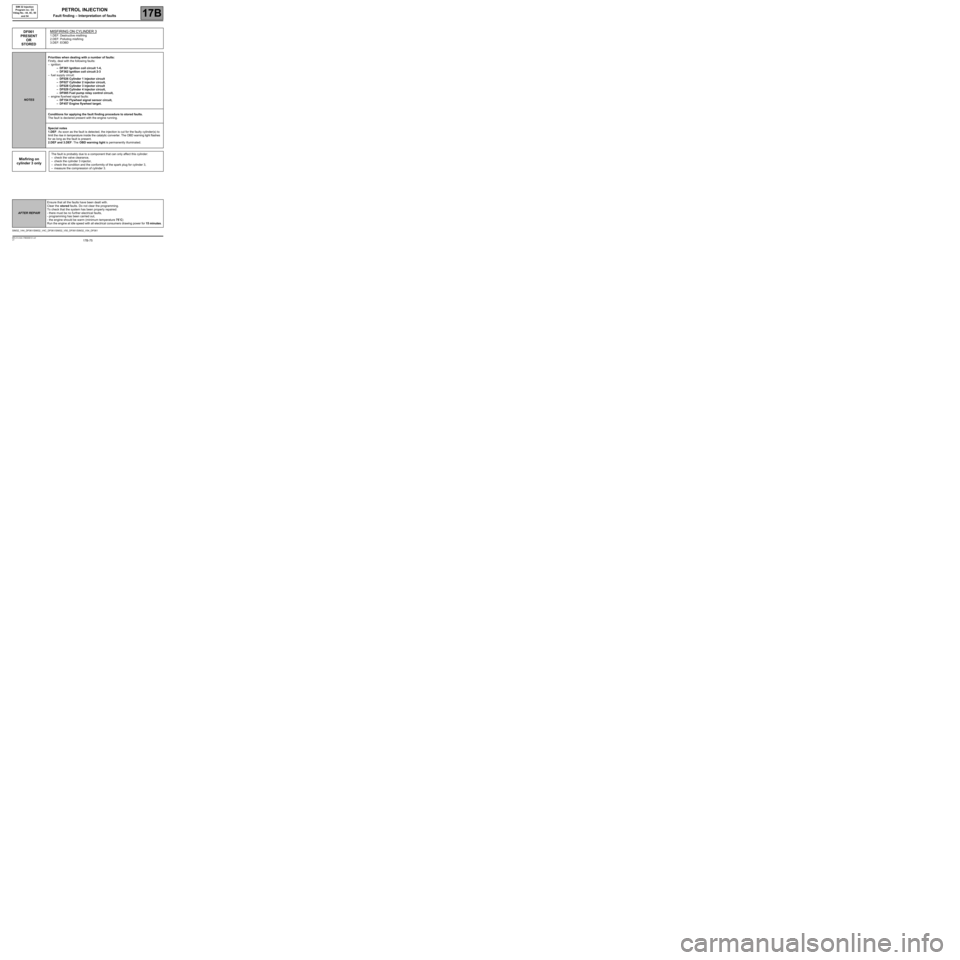
17B-75V7 MR-413-X44-17B000$131.mif
PETROL INJECTION
Fault finding – Interpretation of faults17B
SIM 32 Injection
Program no.: D3
Vdiag No.: 44, 4C, 50
and 54
DF061
PRESENT
OR
STOREDMISFIRING ON CYLINDER 3
1.DEF: Destructive misfiring
2.DEF: Polluting misfiring
3.DEF: EOBD
NOTESPriorities when dealing with a number of faults:
Firstly, deal with the following faults:
–ignition:
–DF361 Ignition coil circuit 1-4,
–DF362 Ignition coil circuit 2-3
–fuel supply circuit:
–DF026 Cylinder 1 injector circuit
–DF027 Cylinder 2 injector circuit,
–DF028 Cylinder 3 injector circuit
–DF029 Cylinder 4 injector circuit,
–DF085 Fuel pump relay control circuit,
–engine flywheel signal faults:
–DF154 Flywheel signal sensor circuit,
–DF457 Engine flywheel target.
Conditions for applying the fault finding procedure to stored faults.
The fault is declared present with the engine running.
Special notes
1.DEF: As soon as the fault is detected, the injection is cut for the faulty cylinder(s) to
limit the rise in temperature inside the catalytic converter. The OBD warning light flashes
for as long as the fault is present.
2.DEF and 3.DEF: The OBD warning light is permanently illuminated.
Misfiring on
cylinder 3 only
The fault is probably due to a component that can only affect this cylinder:
–check the valve clearance,
–check the cylinder 3 injector,
–check the condition and the conformity of the spark plug for cylinder 3,
–measure the compression of cylinder 3.
SIM32_V44_DF061/SIM32_V4C_DF061/SIM32_V50_DF061/SIM32_V54_DF061
AFTER REPAIREnsure that all the faults have been dealt with.
Clear the stored faults. Do not clear the programming.
To check that the system has been properly repaired:
- there must be no further electrical faults,
- programming has been carried out,
- the engine should be warm (minimum temperature 75˚C)
Run the engine at idle speed with all electrical consumers drawing power for 15 minutes.
Page 78 of 348
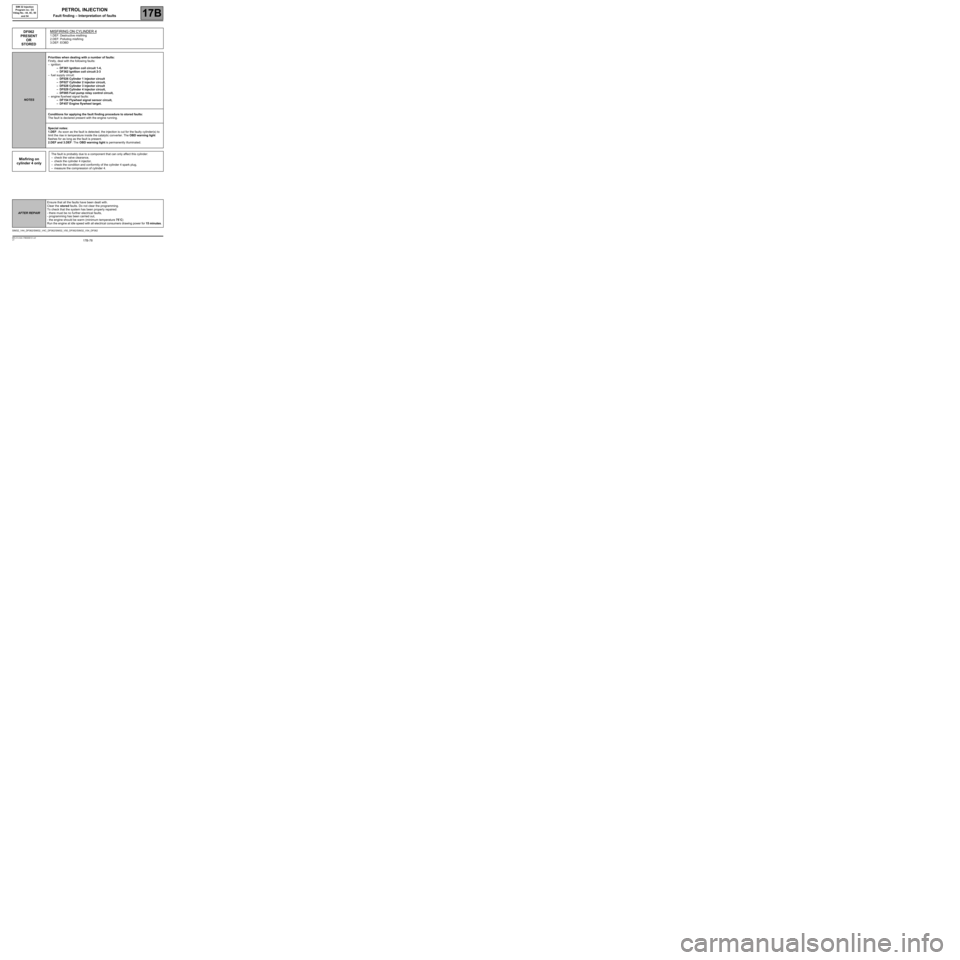
17B-78V7 MR-413-X44-17B000$131.mif
PETROL INJECTION
Fault finding – Interpretation of faults17B
SIM 32 Injection
Program no.: D3
Vdiag No.: 44, 4C, 50
and 54
DF062
PRESENT
OR
STOREDMISFIRING ON CYLINDER 4
1.DEF: Destructive misfiring
2.DEF: Polluting misfiring
3.DEF: EOBD
NOTESPriorities when dealing with a number of faults:
Firstly, deal with the following faults:
–ignition:
–DF361 Ignition coil circuit 1-4,
–DF362 Ignition coil circuit 2-3
–fuel supply circuit:
–DF026 Cylinder 1 injector circuit
–DF027 Cylinder 2 injector circuit,
–DF028 Cylinder 3 injector circuit
–DF029 Cylinder 4 injector circuit,
–DF085 Fuel pump relay control circuit,
–engine flywheel signal faults:
–DF154 Flywheel signal sensor circuit,
–DF457 Engine flywheel target.
Conditions for applying the fault finding procedure to stored faults:
The fault is declared present with the engine running.
Special notes:
1.DEF: As soon as the fault is detected, the injection is cut for the faulty cylinder(s) to
limit the rise in temperature inside the catalytic converter. The OBD warning light
flashes for as long as the fault is present.
2.DEF and 3.DEF: The OBD warning light is permanently illuminated.
Misfiring on
cylinder 4 only
The fault is probably due to a component that can only affect this cylinder:
–check the valve clearance,
–check the cylinder 4 injector,
–check the condition and conformity of the cylinder 4 spark plug,
–measure the compression of cylinder 4.
SIM32_V44_DF062/SIM32_V4C_DF062/SIM32_V50_DF062/SIM32_V54_DF062
AFTER REPAIREnsure that all the faults have been dealt with.
Clear the stored faults. Do not clear the programming.
To check that the system has been properly repaired:
- there must be no further electrical faults,
- programming has been carried out,
- the engine should be warm (minimum temperature 75˚C)
Run the engine at idle speed with all electrical consumers drawing power for 15 minutes.
Page 84 of 348
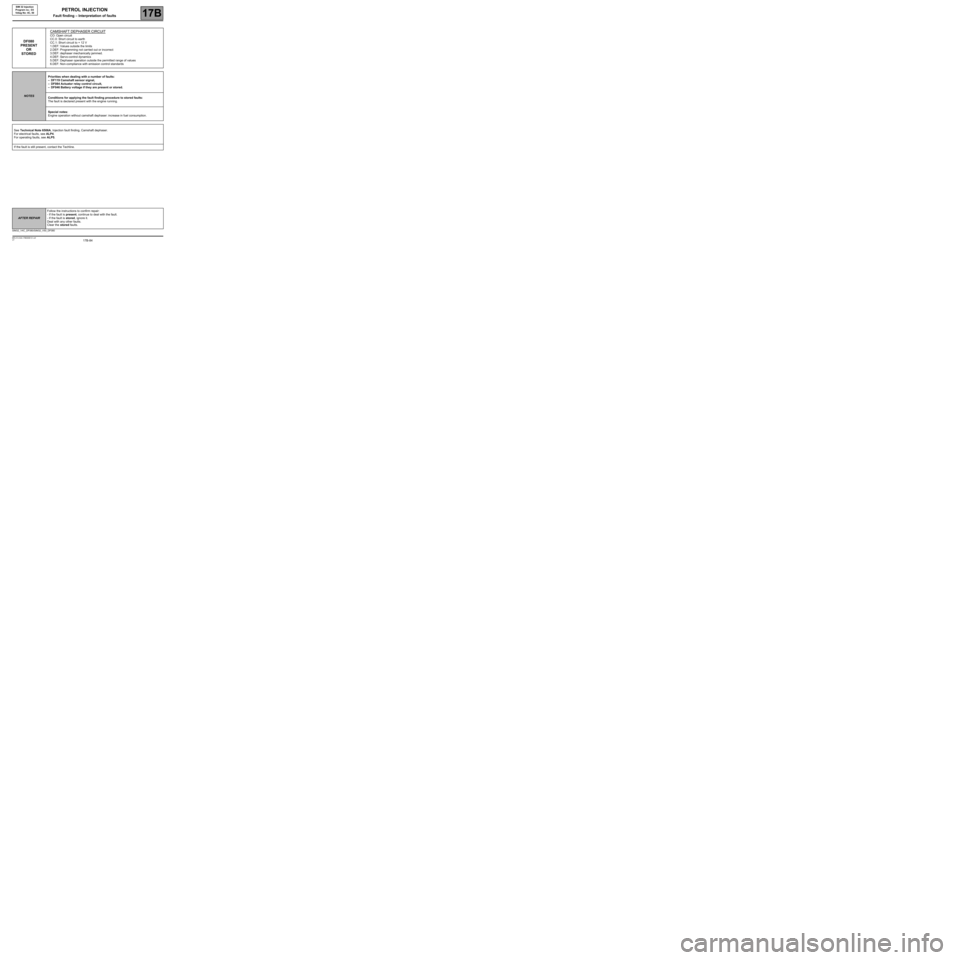
17B-84V7 MR-413-X44-17B000$131.mif
PETROL INJECTION
Fault finding – Interpretation of faults17B
SIM 32 Injection
Program no.: D3
Vdiag No: 4C, 50
DF080
PRESENT
OR
STOREDCAMSHAFT DEPHASER CIRCUIT
CO: Open circuit
CC.0: Short circuit to earth
CC.1: Short circuit to + 12 V
1.DEF: Values outside the limits
2.DEF: Programming not carried out or incorrect
3.DEF: dephaser mechanically jammed.
4.DEF: Servo-control dynamics
5.DEF: Dephaser operation outside the permitted range of values
6.DEF: Non-compliance with emission control standards
NOTESPriorities when dealing with a number of faults:
–DF119 Camshaft sensor signal,
–DF084 Actuator relay control circuit,
–DF046 Battery voltage if they are present or stored.
Conditions for applying the fault finding procedure to stored faults:
The fault is declared present with the engine running.
Special notes:
Engine operation without camshaft dephaser: increase in fuel consumption.
See Technical Note 6506A, Injection fault finding, Camshaft dephaser.
For electrical faults, see ALP4.
For operating faults, see ALP5.
If the fault is still present, contact the Techline.
SIM32_V4C_DF080/SIM32_V50_DF080
AFTER REPAIRFollow the instructions to confirm repair:
- If the fault is present, continue to deal with the fault.
- If the fault is stored, ignore it.
Deal with any other faults.
Clear the stored faults.
Page 85 of 348
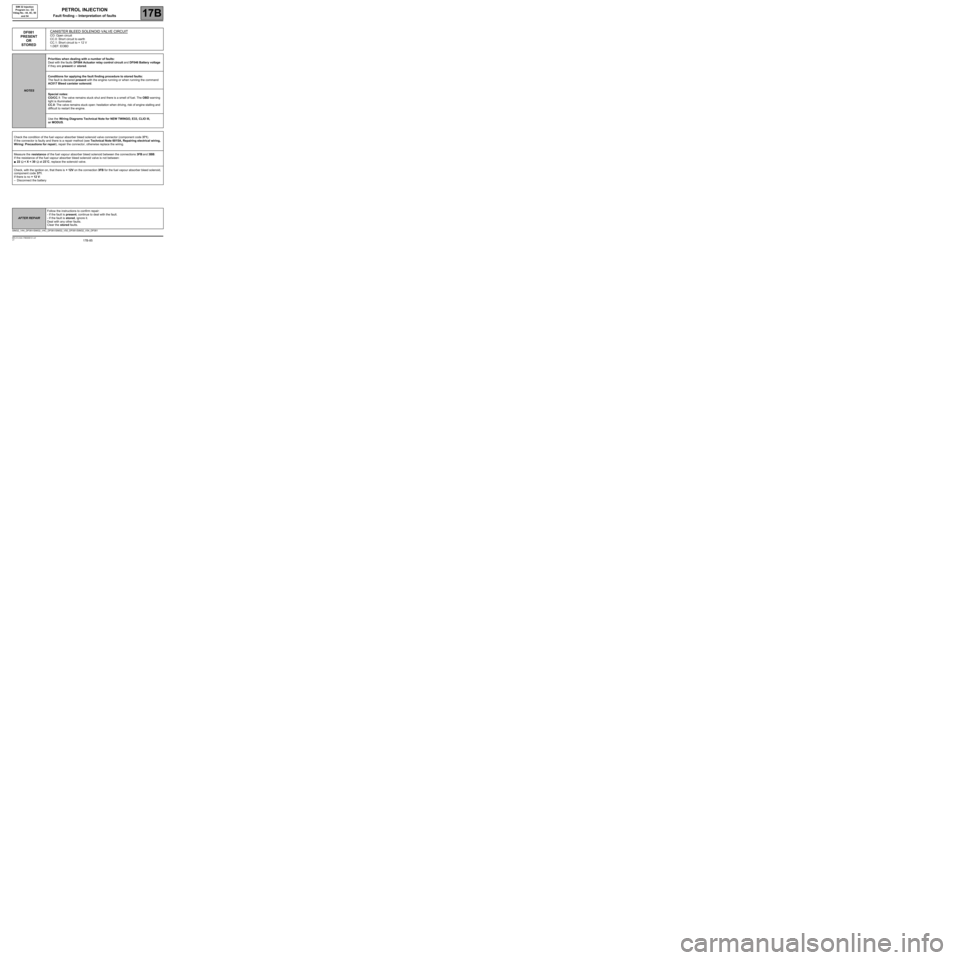
17B-85V7 MR-413-X44-17B000$131.mif
PETROL INJECTION
Fault finding – Interpretation of faults17B
SIM 32 Injection
Program no.: D3
Vdiag No.: 44, 4C, 50
and 54
DF081
PRESENT
OR
STOREDCANISTER BLEED SOLENOID VALVE CIRCUITCO: Open circuit
CC.0: Short circuit to earth
CC.1: Short circuit to + 12 V
1.DEF: EOBD
NOTESPriorities when dealing with a number of faults:
Deal with the faults DF084 Actuator relay control circuit and DF046 Battery voltage
if they are present or stored.
Conditions for applying the fault finding procedure to stored faults:
The fault is declared present with the engine running or when running the command
AC017 Bleed canister solenoid.
Special notes:
CO/CC.1: The valve remains stuck shut and there is a smell of fuel. The OBD warning
light is illuminated.
CC.0: The valve remains stuck open: hesitation when driving, risk of engine stalling and
difficult to restart the engine.
Use the Wiring Diagrams Technical Note for NEW TWINGO, E33, CLIO III,
or MODUS.
Check the condition of the fuel vapour absorber bleed solenoid valve connector (component code 371).
If the connector is faulty and there is a repair method (see Technical Note 6015A, Repairing electrical wiring,
Wiring: Precautions for repair), repair the connector, otherwise replace the wiring.
Measure the resistance of the fuel vapour absorber bleed solenoid between the connections 3FB and 3BB:
If the resistance of the fuel vapour absorber bleed solenoid valve is not between:
●22 Ω < X < 30 Ω at 23˚C, replace the solenoid valve.
Check, with the ignition on, that there is + 12V on the connection 3FB for the fuel vapour absorber bleed solenoid,
component code 371.
If there is no + 12 V:
–Disconnect the battery
SIM32_V44_DF081/SIM32_V4C_DF081/SIM32_V50_DF081/SIM32_V54_DF081
AFTER REPAIRFollow the instructions to confirm repair:
- If the fault is present, continue to deal with the fault.
- If the fault is stored, ignore it.
Deal with any other faults.
Clear the stored faults.
Page 86 of 348
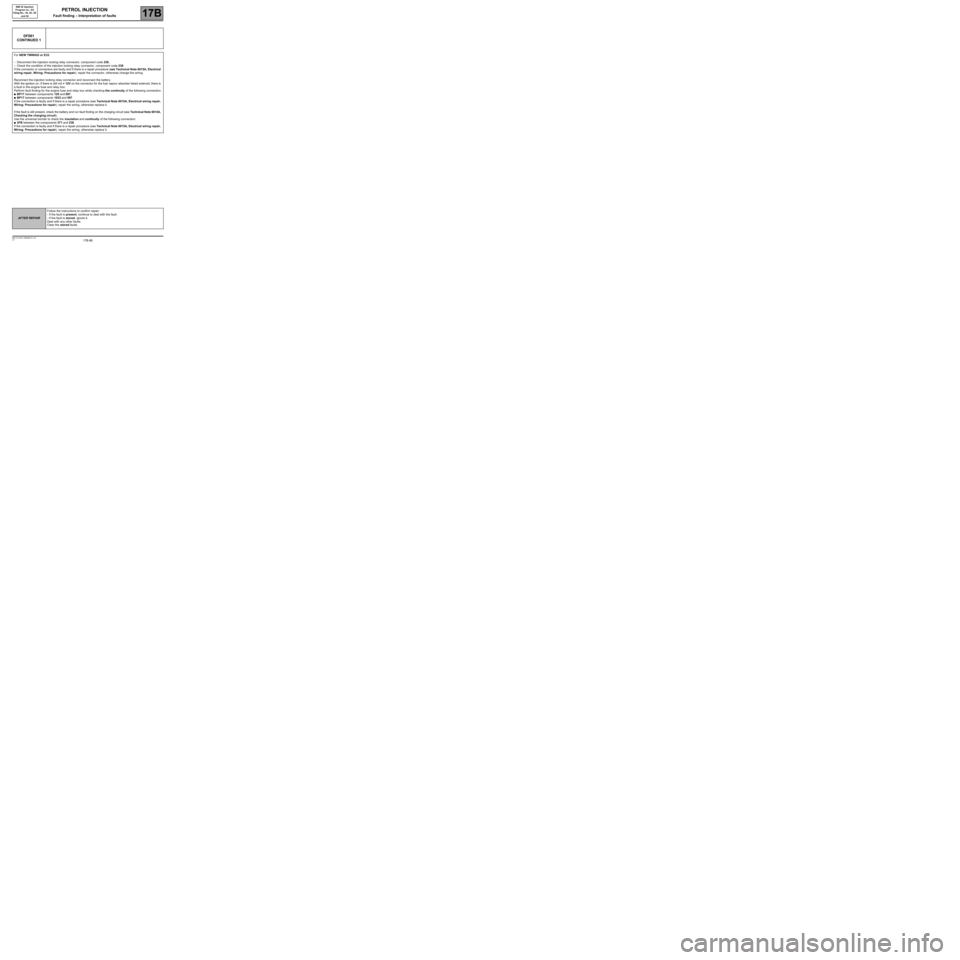
17B-86V7 MR-413-X44-17B000$131.mif
PETROL INJECTION
Fault finding – Interpretation of faults17B
SIM 32 Injection
Program no.: D3
Vdiag No.: 44, 4C, 50
and 54
DF081
CONTINUED 1
For NEW TWINGO or E33:
–Disconnect the injection locking relay connector, component code 238,
–Check the condition of the injection locking relay connector, component code 238.
If the connector or connectors are faulty and if there is a repair procedure (see Technical Note 6015A, Electrical
wiring repair, Wiring: Precautions for repair), repair the connector, otherwise change the wiring.
Reconnect the injection locking relay connector and reconnect the battery.
With the ignition on, if there is still not + 12V on the connector for the fuel vapour absorber bleed solenoid, there is
a fault in the engine fuse and relay box.
Perform fault finding for the engine fuse and relay box while checking the continuity of the following connection:
●BP17 between components 120 and 597,
●BP17 between components 1033 and 597.
If the connection is faulty and if there is a repair procedure (see Technical Note 6015A, Electrical wiring repair,
Wiring: Precautions for repair), repair the wiring, otherwise replace it.
If the fault is still present, check the battery and run fault finding on the charging circuit (see Technical Note 6014A,
Checking the charging circuit).
Use the universal bornier to check the insulation and continuity of the following connection:
●3FB between the components 371 and 238.
If the connection is faulty and if there is a repair procedure (see Technical Note 6015A, Electrical wiring repair,
Wiring: Precautions for repair), repair the wiring, otherwise replace it.
AFTER REPAIRFollow the instructions to confirm repair:
- If the fault is present, continue to deal with the fault.
- If the fault is stored, ignore it.
Deal with any other faults.
Clear the stored faults.
Page 89 of 348
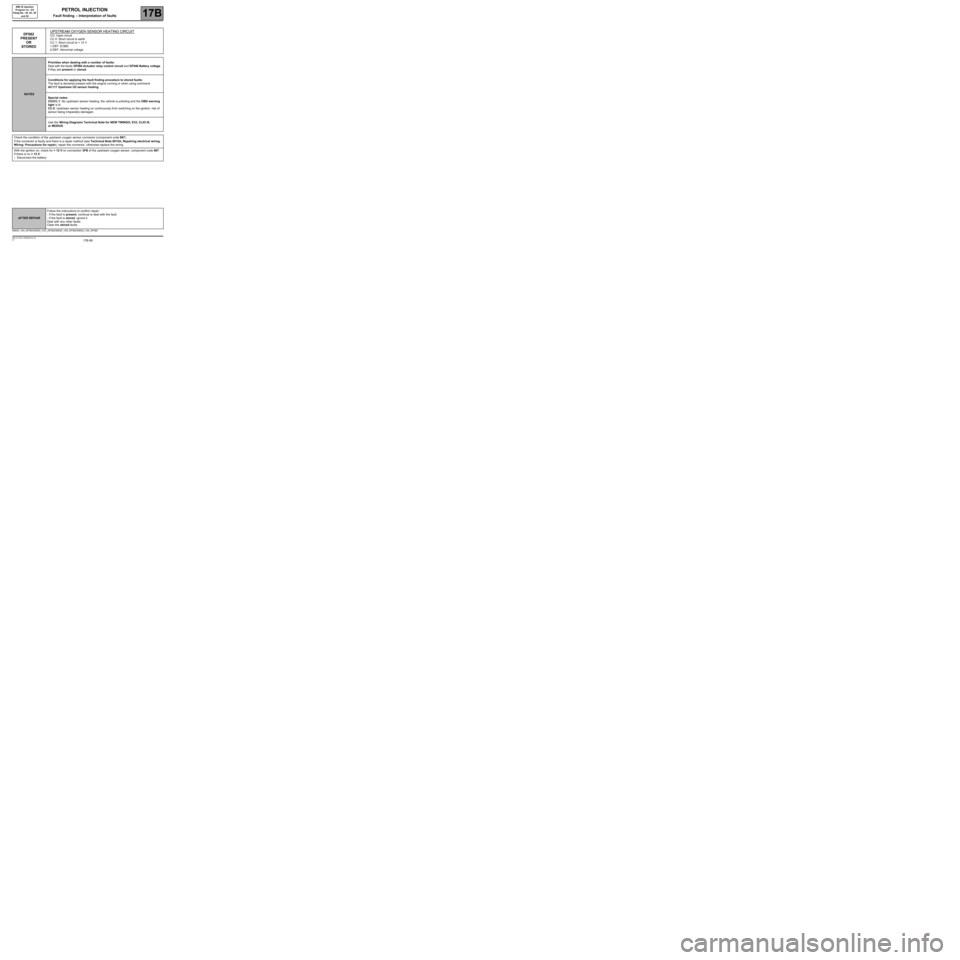
17B-89V7 MR-413-X44-17B000$132.mif
17B
SIM 32 Injection
Program no.: D3
Vdiag No.: 44, 4C, 50
and 54
DF082
PRESENT
OR
STOREDUPSTREAM OXYGEN SENSOR HEATING CIRCUITCO: Open circuit
CC.0: Short circuit to earth
CC.1: Short circuit to + 12 V
1.DEF: EOBD
2.DEF: Abnormal voltage
NOTESPriorities when dealing with a number of faults:
Deal with the faults DF084 Actuator relay control circuit and DF046 Battery voltage
if they are present or stored.
Conditions for applying the fault finding procedure to stored faults:
The fault is declared present with the engine running or when using command
AC117 Upstream O2 sensor heating.
Special notes:
CO/CC.1: No upstream sensor heating: the vehicle is polluting and the OBD warning
light is lit.
CC.0: Upstream sensor heating on continuously from switching on the ignition: risk of
sensor being irreparably damaged.
Use the Wiring Diagrams Technical Note for NEW TWINGO, E33, CLIO III,
or MODUS.
Check the condition of the upstream oxygen sensor connector (component code 887).
If the connector is faulty and there is a repair method (see Technical Note 6015A, Repairing electrical wiring,
Wiring: Precautions for repair), repair the connector, otherwise replace the wiring.
With the ignition on, check for + 12 V on connection 3FB of the upstream oxygen sensor, component code 887.
If there is no + 12 V:
–Disconnect the battery
SIM32_V44_DF082/SIM32_V4C_DF082/SIM32_V50_DF082/SIM32_V54_DF082
AFTER REPAIRFollow the instructions to confirm repair:
- If the fault is present, continue to deal with the fault.
- If the fault is stored, ignore it.
Deal with any other faults.
Clear the stored faults.
PETROL INJECTION
Fault finding – Interpretation of faults
Page 90 of 348
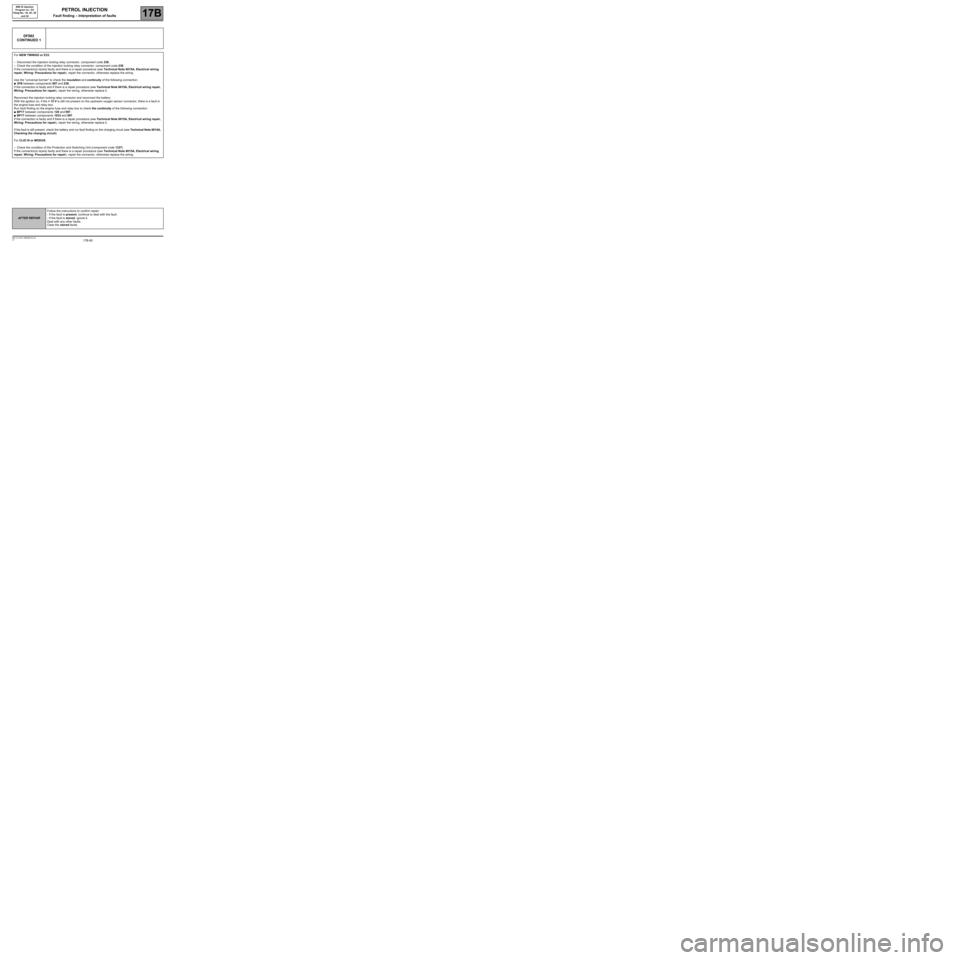
17B-90V7 MR-413-X44-17B000$132.mif
PETROL INJECTION
Fault finding – Interpretation of faults17B
SIM 32 Injection
Program no.: D3
Vdiag No.: 44, 4C, 50
and 54
DF082
CONTINUED 1
For NEW TWINGO or E33:
–Disconnect the injection locking relay connector, component code 238,
–Check the condition of the injection locking relay connector, component code 238.
If the connector(s) is(are) faulty and there is a repair procedure (see Technical Note 6015A, Electrical wiring
repair, Wiring: Precautions for repair), repair the connector, otherwise replace the wiring.
Use the "universal bornier" to check the insulation and continuity of the following connection:
●3FB between components 887 and 238,
If the connection is faulty and if there is a repair procedure (see Technical Note 6015A, Electrical wiring repair,
Wiring: Precautions for repair), repair the wiring, otherwise replace it.
Reconnect the injection locking relay connector and reconnect the battery.
With the ignition on, if the + 12 V is still not present on the upstream oxygen sensor connector, there is a fault in
the engine fuse and relay box.
Run fault finding on the engine fuse and relay box to check the continuity of the following connection:
●BP17 between components 120 and 597,
●BP17 between components 1033 and 597.
If the connection is faulty and if there is a repair procedure (see Technical Note 6015A, Electrical wiring repair,
Wiring: Precautions for repair), repair the wiring, otherwise replace it.
If the fault is still present, check the battery and run fault finding on the charging circuit (see Technical Note 6014A,
Checking the charging circuit).
For CLIO III or MODUS:
–Check the condition of the Protection and Switching Unit (component code 1337).
If the connector(s) is(are) faulty and there is a repair procedure (see Technical Note 6015A, Electrical wiring
repair, Wiring: Precautions for repair), repair the connector, otherwise replace the wiring.
AFTER REPAIRFollow the instructions to confirm repair:
- If the fault is present, continue to deal with the fault.
- If the fault is stored, ignore it.
Deal with any other faults.
Clear the stored faults.
Page 92 of 348
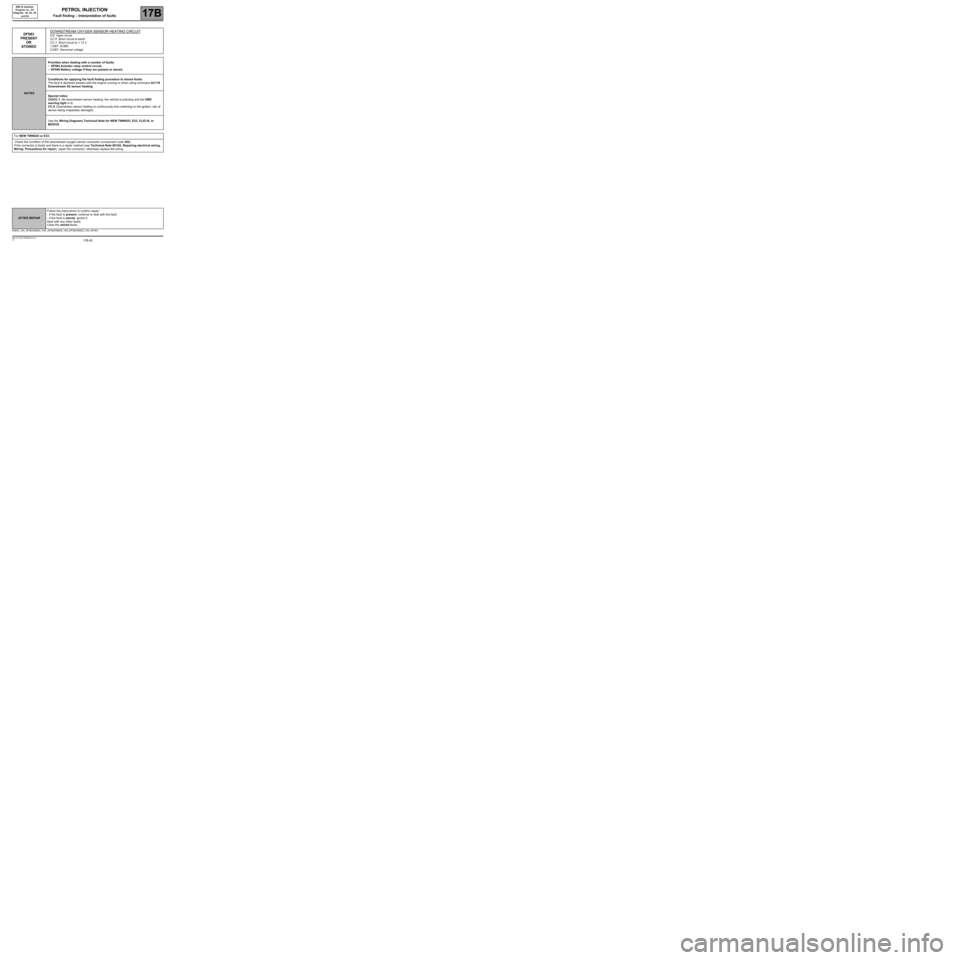
17B-92V7 MR-413-X44-17B000$132.mif
PETROL INJECTION
Fault finding – Interpretation of faults17B
SIM 32 Injection
Program no.: D3
Vdiag No.: 44, 4C, 50
and 54
DF083
PRESENT
OR
STOREDDOWNSTREAM OXYGEN SENSOR HEATING CIRCUITCO: Open circuit
CC.0: Short circuit to earth
CC.1: Short circuit to + 12 V
1.DEF: EOBD
2.DEF: Abnormal voltage
NOTESPriorities when dealing with a number of faults:
–DF084 Actuator relay control circuit,
–DF046 Battery voltage if they are present or stored.
Conditions for applying the fault finding procedure to stored faults:
The fault is declared present with the engine running or when using command AC118
Downstream O2 sensor heating.
Special notes:
CO/CC.1: No downstream sensor heating: the vehicle is polluting and the OBD
warning light is lit.
CC.0: Downstream sensor heating on continuously from switching on the ignition: risk of
sensor being irreparably damaged.
Use the Wiring Diagrams Technical Note for NEW TWINGO, E33, CLIO III, or
MODUS.
For NEW TWINGO or E33:
Check the condition of the downstream oxygen sensor connector (component code 242).
If the connector is faulty and there is a repair method (see Technical Note 6015A, Repairing electrical wiring,
Wiring: Precautions for repair), repair the connector, otherwise replace the wiring.
SIM32_V44_DF083/SIM32_V4C_DF083/SIM32_V50_DF083/SIM32_V54_DF083
AFTER REPAIRFollow the instructions to confirm repair:
- If the fault is present, continue to deal with the fault.
- If the fault is stored, ignore it.
Deal with any other faults.
Clear the stored faults.